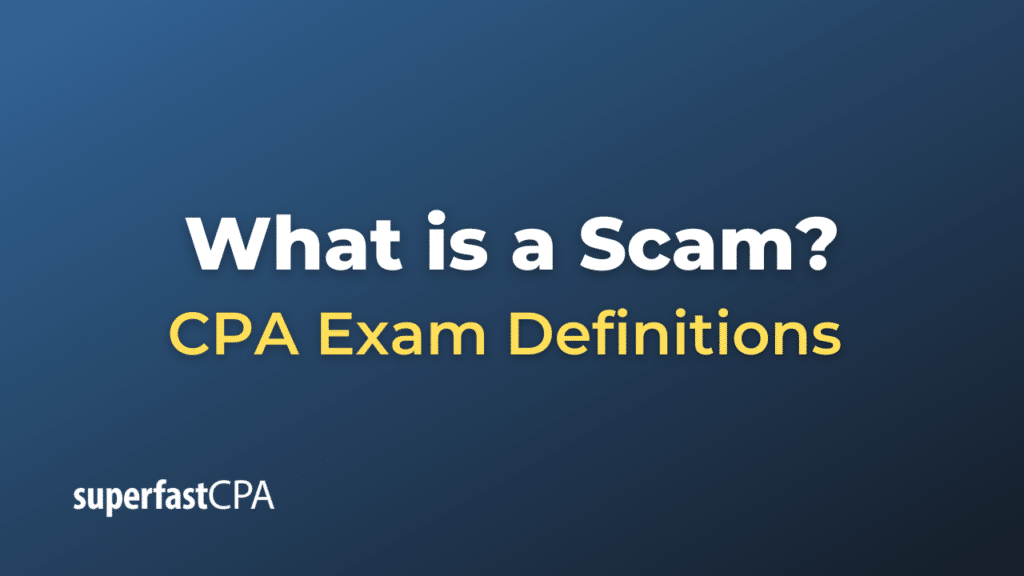Scam
A scam is a deceptive scheme or trick used to cheat someone out of something, typically money. Scammers use a variety of tactics to appear legitimate, creating detailed stories, manipulating emotions, or, in some cases, using aggressive tactics to get their victims to fall for their deceit.
Here are some common types of scams:
- Phishing Scams: These involve tricking individuals into giving out their personal information, such as passwords or credit card numbers. Often, scammers use emails, texts, or phone calls pretending to be from a legitimate organization, such as a bank, to ask individuals to verify or update their details.
- Nigerian or 419 Scams: This is one of the most well-known scams. It involves someone overseas offering you a share in a large sum of money or a payment on the condition you help them transfer money out of their country.
- Lottery and Sweepstakes Scams: Victims are told they have won a large amount of money in a lottery or sweepstakes, which they did not enter. They might be asked to pay a fee or provide personal information to claim their “winnings.”
- Tech Support Scams: Scammers claim to be tech support from a well-known company, saying they’ve found a problem with your computer. They then ask for access to your computer and might install malware, charge you for unnecessary services, or ask for payment details.
- Romance Scams: Scammers create fake profiles on dating sites or apps, establishing relationships and then exploiting emotional vulnerabilities to get money, gifts, or personal details.
- Investment Scams: These scams promise high returns with little or no risk. The investments are typically fake, too good to be true, or involve “hot tips” or insider information.
- Rental Scams: Scammers post fake rental listings at attractive prices, asking for deposits or rent payments before the potential tenant realizes the property doesn’t exist or is owned by someone else.
- Tax Scams: Individuals are contacted by someone claiming to be from a tax agency, saying they owe money and threatening penalties if not paid immediately.
- Charity Scams: Fake charities are set up to exploit people’s generosity. They often pop up after natural disasters.
To avoid falling victim to scams:
- Always be skeptical of unsolicited communications.
- Don’t give out personal or financial information without thorough verification.
- Take your time; scammers often create a sense of urgency.
- Conduct independent research before making decisions.
- Be cautious with links and attachments in unexpected emails.
- Seek advice from trusted individuals or professionals when unsure.
If you suspect something is a scam or if you’ve been scammed, it’s essential to report it to the appropriate authorities to help prevent others from being victims.
Example of a Scam
Let’s delve into one of the most common and insidious types of scams: the phishing scam.
Scenario: The Phishing Email
One day, Jane receives an email that appears to come from her bank. The email has the bank’s logo, the design looks professional, and it seems legitimate at first glance.
Email Contents:
Subject: Urgent Action Required: Unauthorized Login Attempt Detected!
Dear Jane,
We’ve detected a potential unauthorized login attempt on your account from a location in Moscow, Russia. For your safety, we’ve temporarily locked your account.
To verify your identity and regain access to your account, click the link below:
Verify My Account
It’s crucial for your account’s safety to address this issue immediately.
Warm regards, YourBank Customer Support
Red Flags and Analysis:
- Unsolicited Email: Jane did not receive any notification on her bank app or via SMS about any unauthorized attempts. Often, legitimate institutions have multiple ways of notifying their customers.
- Generic Greeting: The email starts with “Dear Jane” instead of a more personalized greeting. Banks usually use full names or other specific identifiers when addressing their customers.
- Urgency: Scammers often try to create a sense of urgency to make victims act without thinking. The email insists on immediate action, pushing Jane to click the link without further verification.
- Suspicious Link: Hovering over the “Verify My Account” link, Jane notices the web address doesn’t match her bank’s official website. It’s a slight variation designed to look similar but leads to a fake site.
What Could Happen Next:
If Jane clicks the link, she might be taken to a website that looks just like her bank’s login page. If she enters her login credentials, the scammers would capture this information, giving them actual access to her bank account.
Alternatively, the link could download malware onto her computer, compromising her data and potentially leading to other cybercrimes.
The Right Response:
Instead of clicking the link, Jane should:
- Avoid interacting with the email.
- Contact her bank directly using official contact details (from the bank’s website or the number on the back of her bank card) to verify if there was any actual concern.
- Report the phishing email to the appropriate authorities and her bank to help them be aware and potentially warn other customers.
This example illustrates the importance of scrutinizing unsolicited communications, especially those prompting urgent action, and always verifying with the official source before taking any action.













